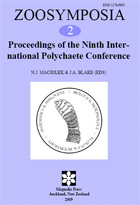Abstract
The form and arrangement of hardened paragnaths on the pharynx of polychaetes in the family Nereididae has for 150 years been used as a principal system of characters to distinguish species and other taxonomic ranks. Recent studies have shown that phylogenetic relationships based solely on paragnaths give different topologies and clade support than relationships inferred from other character systems. Furthermore, recent revisions and species descriptions continue to increase the range of known paragnath forms. We provide the first comprehensive overview of these important morphological characters, with the aim of encouraging more consistent observation and use of a standardized terminology in future studies. Illustrated descriptions and definitions of all known paragnath types are presented and compared. New terminology is introduced to improve description of paragnath types. Hypotheses are proposed for the chemical composition of paragnaths (scleroprotein), homology between different paragnaths types, and earlier studies implicitly proposing the homology of scleroprotein paragnaths with the more plesiomorphic pharyngeal soft papillae are addressed.

